The Samsung 850 EVO 4TB SSD Review
by Billy Tallis on July 11, 2016 10:00 AM ESTAnandTech Storage Bench - The Destroyer
The Destroyer is an extremely long test replicating the access patterns of very IO-intensive desktop usage. A detailed breakdown can be found in this article. Like real-world usage and unlike our Iometer tests, the drives do get the occasional break that allows for some background garbage collection and flushing caches, but those idle times are limited to 25ms so that it doesn't take all week to run the test.
We quantify performance on this test by reporting the drive's average data throughput, a few data points about its latency, and the total energy used by the drive over the course of the test.
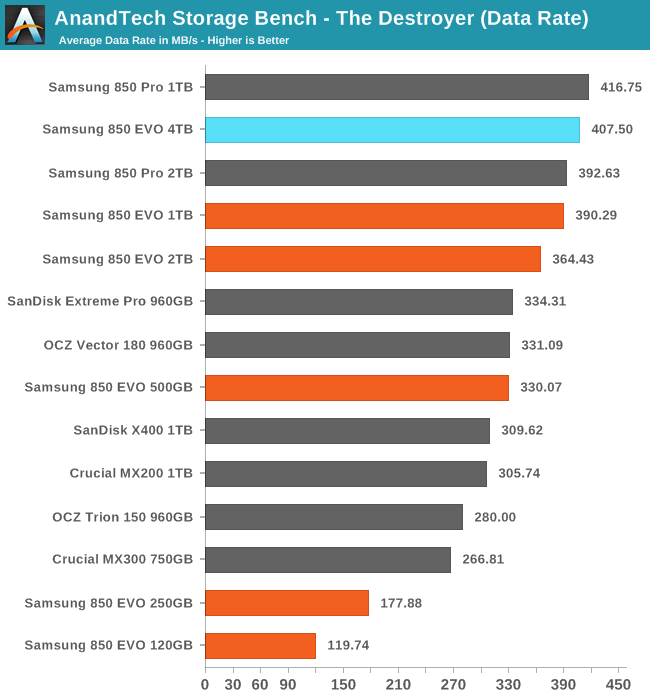
The Destroyer isn't enough to really challenge the 4TB 850 EVO, as this test doesn't write enough data to fill the drive even halfway. The 1TB 850 Pro still holds the record for the highest average data rate maintained by a SATA drive, but the 4TB EVO is closer to that than to any slower drive.
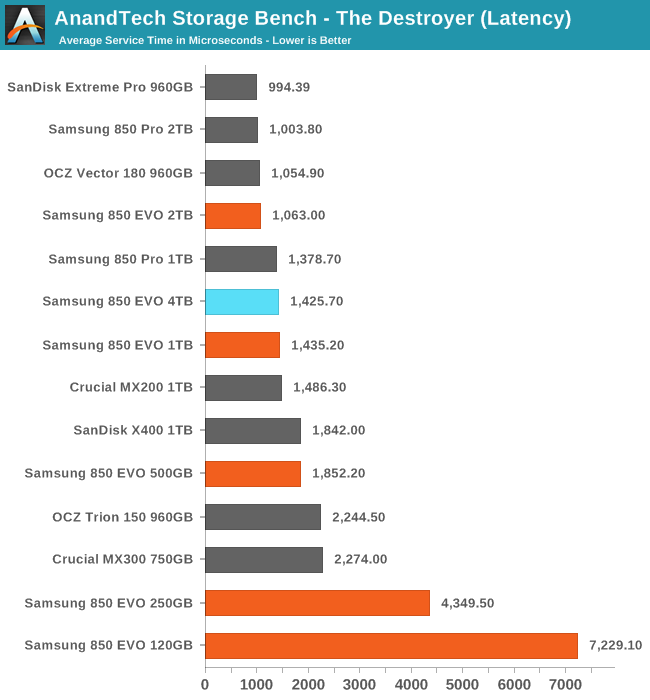
After the 2TB 850 Pro and EVO managed to tie with the top tier of drives for average service time, it is a little disappointing to see the 4TB 850 EVO only manages to match the 1TB models, but that's still high-end performance.
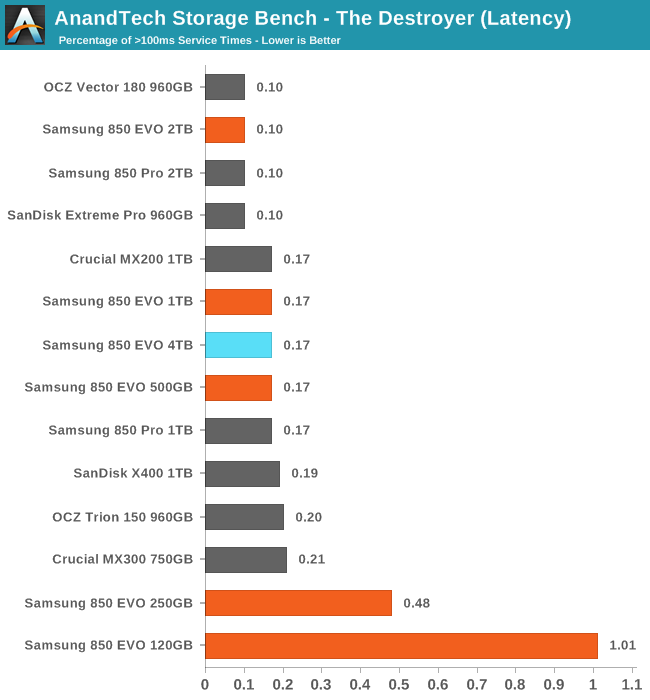
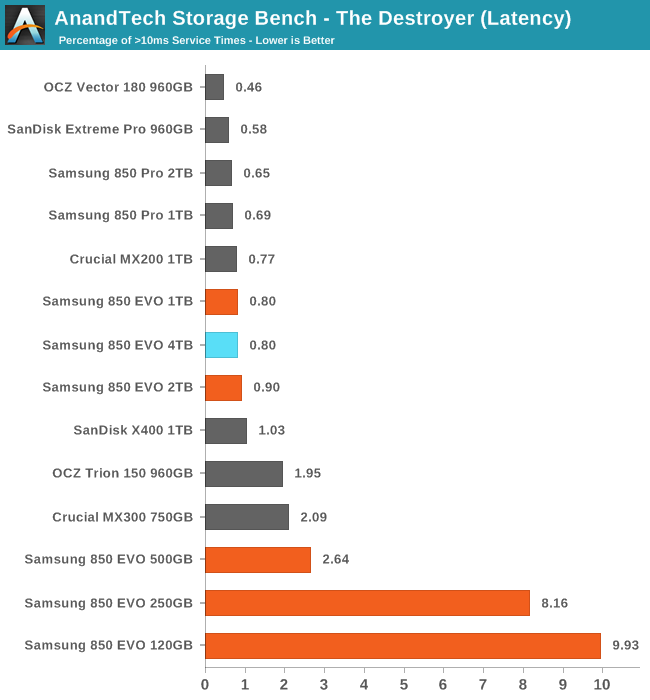
The 4TB 850 EVO has slightly more extreme latency outliers than the 2TB 850s, but at the more strict threshold of 10ms it is tied with the 1TB 850 EVO for being the best TLC drive.
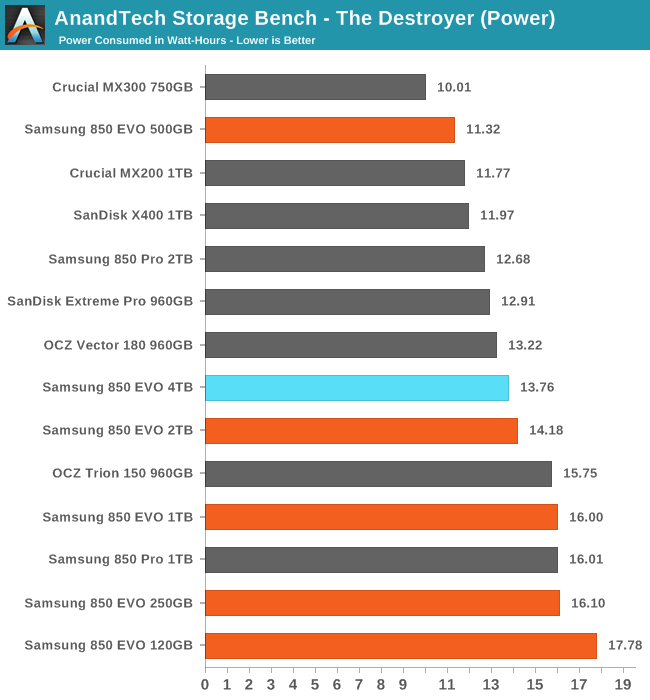
The 4TB 850 EVO brings a little more reduction in power use over the 2TB 850 EVO, which substantially cut power use relative to the 1TB model. The 4TB drive is clearly not paying any significant penalty for keeping so much flash and DRAM powered up.










145 Comments
View All Comments
nandnandnand - Monday, July 11, 2016 - link
Weren't the first XPoint parts going to be 16-32 GB? I find $0.65/GB hard to believe... I expect $3.00/GB.nathanddrews - Monday, July 11, 2016 - link
Yeah, I'll believe it when I see it.Kevin G - Monday, July 11, 2016 - link
Where are you seeing this and for what format?I strongly suspect that Intel is going to be price competitive in the NVMe space so that's realistic but I'd expect a massive premium for Xpoint in DIMM format when Skylake-E comes around.
shabby - Monday, July 11, 2016 - link
Why would xpoint dimm be premium priced? They said its slower than dimm, so it should be cheaper.Kevin G - Monday, July 11, 2016 - link
Well what competition would the DIMM format have on SkyLake-E?SATA based SSDs are a dime a dozen and M.2 drives using NVMe are just starting to spread. What competition would Intel have with a DIMM format?
Impulses - Monday, July 11, 2016 - link
There's a lot of pie in the sky dreaming about Xpoint IMO... Why would it be priced at a premium? Same reason M.2 NVMe & PCI-E drives are, it's what the market will bear that counts. If it's any faster it'll be more expensive, simple really.ddriver - Monday, July 11, 2016 - link
Don't hold your breath. They made claims of "ram" speed, but demoed 2 GB/s hardware, which is not much faster than nvme SSDs. Ram is 20-30 GB/s...SSDs can still go a long way in terms of bandwidth - just snap more chips on more channels, given an available interface to hook it to, it would be too much trouble for the industry to create something like 8 GB/s SSD. And it only requires a better controller chip, can work with the same old flash memory chips. Currently, M2 can only provide theoretical 4 GB/s bandwidth, running at 32 gbit.
Eden-K121D - Monday, July 11, 2016 - link
a PCIe gen4 device could have potential read speeds of 8GB/sKevin G - Monday, July 11, 2016 - link
The 2 GB/s demo was using a Thunderbolt enclosure and an M.2 prototype.Full size PCIe and DIMM formats are planned so I'd consider that 2 GB demo the starting point.
benedict - Monday, July 11, 2016 - link
Horrible write endurance. If you need a drive that big you certainly have enough data to fill it 75 times.